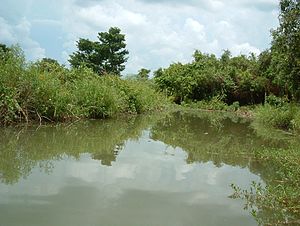A project worth US$500,000 has begun to restore the Lang Sen Wetland Reserve in southern Vietnam’s Long An Province, the reserve management announced on Monday.
The project, called “Protecting life in the context of climatic changes: The community’s livelihood and adaptation based on the Lang Sen Wetland Reserve’s ecosystem,” has been jointly launched by the Federal Ministry for Economic Cooperation and Development and the World Wide Fund for Nature (WWF) in Germany. The WWF in Vietnam has joined hands with the provincial Department of Agricultural and Rural Development to complete the project within four years, according to Truong Thanh Son, director of the Lang Sen reserve.
In recent years, the swamps surrounding the reserve have experienced serious erosion and damage due to the wetland’s conversion into paddy fields and inadequate management of water resources.
The project will help restore the reserve’s natural characteristics using a new aquatic regime which is similar to the natural currents, and boost management capacity of the wetland, its water resources, flora and fauna, Son added.
He added the project will also relieve the impact of climate change on the surrounding community by launching smart, climate-adapted agricultural models among more than 180 households of farmers and fishermen living in the vicinity.
It also allows local households to learn more about the sustainable use of wetland natural resources.
According to the WWF in Vietnam, Lang Sen Wetland Reserve, whose name literally means “the wetland with many lotus flowers,” includes 50 hectares of lotus plants as well as 40 hectares of wild rice.
Covering a total area of more than 5,030 hectares in Tan Hung District, the Lang Sen reserve, formed in January 2004, provides an ideal microcosm of the natural landscape of the pristine Dong Thap Muoi (Plain of Reeds.)
The area is home to thousands of wetland birds, hundreds of species of freshwater fish, 156 species of wild plants and many amphibians, reptiles and other animals.
Its bird population includes a number of rare, endangered species such as white-winged ducks, brown-backed owls and kingfishers.
Le Van Hoang, director of the provincial agriculture department, said the reserve’s restoration project is a key step in its quest for recognition as a Ramsar site.
A Ramsar site must follow the Ramsar Convention, which is an international treaty for the conservation and sustainable utilization of wetlands recognizing the fundamental ecological functions of wetlands and their economic, cultural, scientific and recreational value.
The convention is named after the Iranian city of Ramsar, where it was signed in 1971.
Late last month Con Dao National Park, located in the Con Dao archipelago administered by the southern province of Ba Ria- Vung Tau, became the world’s 2,203rd Ramsar site upon its official recognition, and the country’s sixth, according to the website http://www.ramsar.org.
Vietnam’s other Ramsar sites include Tram Chim National Park in the Mekong Delta province of Dong Thap, Ca Mau National Park in the southernmost province of Ca Mau, Xuan Thuy Natural Wetland Reserve in the northern province of Nam Dinh, Bau Sau in Cat Tien National Park in the southern province of Dong Nai and Ba Be lake in the mountainous province of Bac Can.






















































